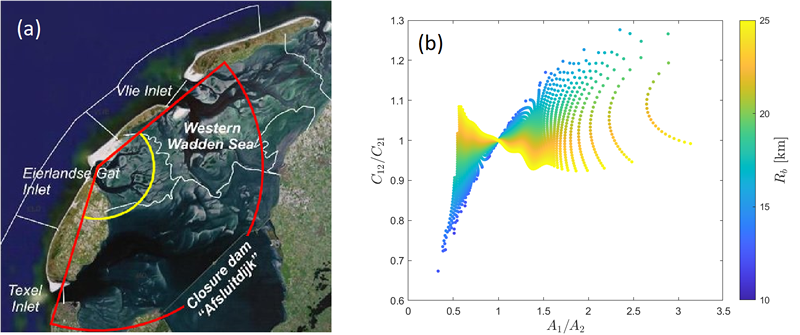W. Ploeg1*, P.C. Roos1, T.M. Duong1,2, H.M. Schuttelaars3
1 University of Twente; 2 IHE Delft; 3 Delft University of Technology
*corresponding author:
Introduction
Barrier coasts are characterised by a chain of barrier islands, separated by tidal inlets, connecting the outer sea to the basin. This study investigates the cross-sectional morphodynamic stability (i.e., whether the system returns to equilibrium after a temporary perturbation of the inlet cross-sectional area) and connectivity of the tidal inlets (i.e., to what extent perturbations at one inlet induce cross-sectional changes of other inlets) in double and triple inlet systems. This study focuses on the Western Wadden Sea, a triple inlet system with a tidal divide circumventing the middle inlet (see Fig. 1a).
Methods
An idealised process-based model based on Escoffier's (1940) principle is developed. The basin takes a plan view shape of a sector of a circle (Fig. 1a, red line) with a tidal divide (yellow) circumventing the middle. This idealisation allows for a largely analytical solution strategy, as also employed by Roos et al. (2013), to compute the stability and connectivity properties of the system, while preserving the main geometric characteristics of the Western Wadden Sea. The connectivity quotient Cij indicates the response of inlet i when perturbing inlet j (Roos & Schuttelaars, NCK 2023).
Results
The results indicate that a stable equilibrium exists for a triple inlet system with this configuration, with and without a tidal divide. Additionally, the interaction in a triple inlet system is more complicated than observed in a double inlet system: an increase of the cross-sectional area of one inlet can lead to a temporary increase of another inlet as well (Cij > 0). The results also indicate that the connectivity among inlets decreases for increasing tidal divide height. Finally, the results show that asymmetry in the connectivity (Cij≠ Cij) is a direct consequence of the asymmetry in the cross-sectional inlet area but depending on the basin area, as shown in Figure 1b. For small basins, perturbing the smaller inlet yields a larger disturbance of the other inlets. Conversely, for large basins, perturbing the larger inlet yields a larger disturbance of the other inlets. This can be explained by the competing effects of the bottom friction in and the pressure gradient over the inlets. Applied to the Western Wadden Sea, the results suggest that the system is stable and that inlets are weakly connected due to the large basin size.

Figure 1: (a) Plan-view of the Western Wadden Sea, including the schematized basin geometry (red) and tidal divide (yellow); (b) Correlation between asymmetry of the inlet connectivities (vertical axis) and asymmetry in inlet areas (horizontal axis) for various basin radii (color).
References
Escoffier, F. F. (1940). The Stability of Tidal Inlets. Shore and Beach, 8, 114–115.
Roos, P. C., Schuttelaars, H. M., & Brouwer, R. L. (2013). Observations of barrier island length explained using an exploratory morphodynamic model. Geophys. Res. Lett., 40(16), 4338–4343.
I. Surname1*, F.N. Another-Surname2 , Y. Next-Surname2
1 University Name, Country; 2 Organization Name, Country
* Corresponding author: mail.name@organization.org


